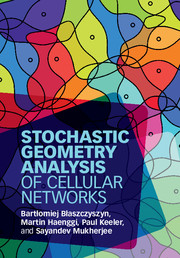Book contents
- Frontmatter
- Contents
- Preface
- Acknowledgments
- Notations
- List of Acronyms and Abbreviations
- Part I Stochastic Geometry
- 1 Introduction
- 2 The Role of Stochastic Geometry in HetNet Analysis
- 3 A Brief Course in Stochastic Geometry
- 4 Statistics of Received Power at the Typical Location
- Part II SINR Analysis
- Concluding Remarks
- Appendix A Proof of Lemma 5.3.6
- Appendix B Timeline of Cellular Technology Generations
- Appendix C Some Useful Probability Distributions
- References
- Index
1 - Introduction
from Part I - Stochastic Geometry
Published online by Cambridge University Press: 26 March 2018
- Frontmatter
- Contents
- Preface
- Acknowledgments
- Notations
- List of Acronyms and Abbreviations
- Part I Stochastic Geometry
- 1 Introduction
- 2 The Role of Stochastic Geometry in HetNet Analysis
- 3 A Brief Course in Stochastic Geometry
- 4 Statistics of Received Power at the Typical Location
- Part II SINR Analysis
- Concluding Remarks
- Appendix A Proof of Lemma 5.3.6
- Appendix B Timeline of Cellular Technology Generations
- Appendix C Some Useful Probability Distributions
- References
- Index
Summary
This chapter discusses the reasons for the importance of heterogeneous network (HetNet) architectures in future wireless network deployments. We begin with a brief survey of the state of wireless networks and the chief challenges faced by designers and operators of such networks. We then discuss possible solutions to these problems and single out small-cell networks as probably the best engineering solution. The deployment of small-cell networks then leads directly to the design and configuration of the resulting heterogeneous networks, which is the focus of this book. We make the case for new approaches to complement the traditional simulation-based schemes for design and performance evaluation when the wireless networks in question are heterogeneous, and provide an overview of the principal results that are now known (and that continue to be added to at a rapid pace), mostly as a result of research done since 2010.
The Demand for Ubiquitous Connectivity
The Information Age and the Computer Age have converged in the form of portable wireless devices that are full-fledged computers and that can, with a connection to the internet, provide instant always-on access to information anywhere. In other words, we are moving toward the “nomadic computing” vision of Kleinrock (Kleinrock 1996), where we can perform information processing “anytime, anywhere,” but instead of doing so in Kleinrock's “disconnected” world, we do so by ensuring that the world is fully “connected.”
The main source of such ubiquitous connectivity, especially for mobile and outdoor users, is the cellular network as it has evolved over three decades and four generations of air interfaces (see Appendix B for details). Indoors, the cellular network is often complemented or even supplanted by a mix of wired and wireless (WiFi) networks, but since the indoor scenario is the simplest one in which to maintain connectedness, we shall focus on outdoor and mobile scenarios in the following discussion of ubiquitous connectivity. At any rate, it is a fait accompli that the cellular model, where base stations serve as exclusive access points to the internet within defined geographical areas called cells, is the foundation for any network that offers such ubiquitous connectivity.
Information
- Type
- Chapter
- Information
- Stochastic Geometry Analysis of Cellular Networks , pp. 3 - 12Publisher: Cambridge University PressPrint publication year: 2018
